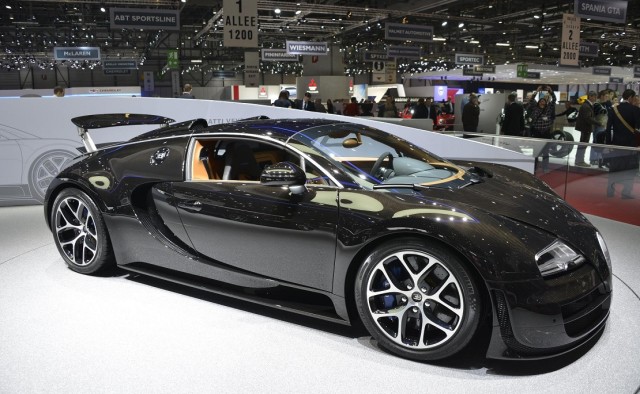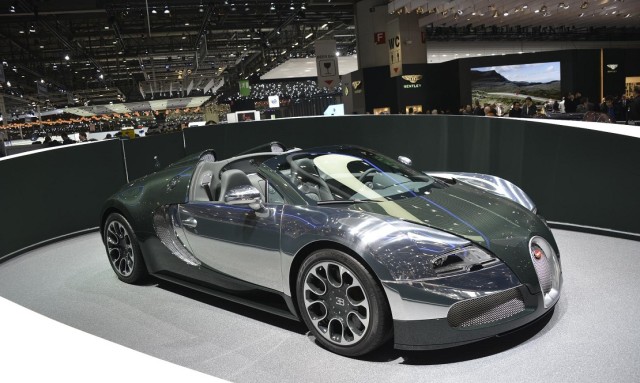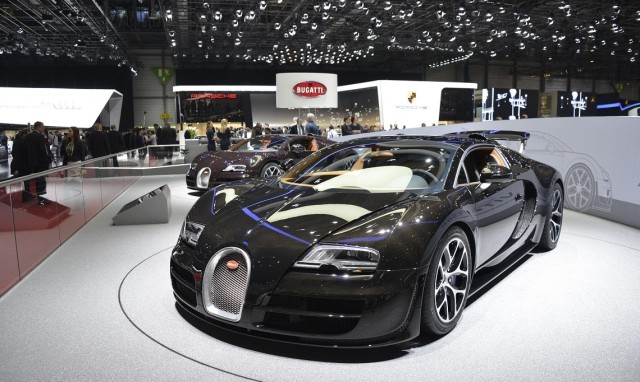


With its 16-cylinder four-wheel drive, the Bugatti Veyron may well be the most sophisticated production vehicle of all times.
Most of the components tucked beneath its hood are ingenious innovations that were formerly only deemed possible by visionaries like Ferdinand Piëch.Boasting a maximum speed of more than 400 km per hour, the Veyron is unmatched in the super sports category. It offers a total of 736 kW (1,001 HP), and its ample power reserves even at high speeds are the fabric of dreams for luxury-class limousines: for a constant speed of 250 km/h, the Veyron only needs 270-280 HP. This means that the seven-gear clutch transmission works with a torque of up to 1,250 Newton meters.The Electronic Stability Program ensures the necessary flexibility and maneuverability at any speed. The Veyron reaches velocities that would literally lift the car off the ground – if it weren’t for its ingenious aerodynamics, which keeps it firmly on the road even at full speed. Adjusting the back spoiler, reducing ground clearance, opening and closing the lids – it all adds to the perfect balance between propulsion and downforce. Such a super sports car may not seem to be brought to a halt easily, but the Veyron’s ceramic brakes slow it down faster than it can accelerate. While it takes this exceptional car only 2.5 seconds to go from 0 to 100 km/h, it needs even less time – a mere 2.3 seconds – to come to a standstill from 100 (reference point). To reduce the risk of injuries in accidents, Bugatti had a Formula 1 safety concept adapted for the Veyron. All these technical details combine to make the Veyron a truly exceptional super sports car.Gearbox: 7 Gear DSG, fuel consumption combined: 24.9l/100km, fuel consumption in town: 41.9l/100km, fuel consumption out of town: 15.6l/100km, CO2 emission combined: 596g/km, Efficiency Class: G
Annual tax for this vehicle €1132
Energy costs at a mileage of 20,000 km:
Fuel costs (Super Plus) at a fuel price of 1.624 EUR/billing unit €8087.52
Created on: 11/30/2011
The values were calculated using the prescribed measurement method (§ 2, numbers 5, 6, 6 per car energy labeling ordinance in its current version).CO2 emissions, which result from the production and provision of fuel or other energy sources are not taken into account in the determination of CO2 emissions pursuant to Directive 1999/94/EC. The figures do not refer to a specific vehicle and are not part of the offer, but only serve the purpose of comparing different vehicle types. The fuel consumption and CO2 emissions of a vehicle not only depend on the efficient utilization of the fuel by the vehicle, but also on driving style and other non-technical factors. CO2 is the main greenhouse gas responsible for global warming. Notice pursuant to Directive 1999/94/EC of each current valid version: For more information on official fuel consumption and the specific official CO2 emissions of new passenger cars can be acquired from the “Guide for Fuel Economy, CO2 Emissions and Power Consumption of New Passenger Cars” available at all sales outlets and at DAT German Automobil Treuhand GmbH, Hellmuth-Hirth-Strasse 1, D-73760 Ostfildern – available free of charge or at www.dat.de. Efficiency classes of vehicles are evaluated in terms of CO2 emissions by means of the vehicle’s empty weight. Vehicles that correspond to the average are classified as D. Vehicles that are better are graded with A+, A, B or C. Vehicles that are worse than the average are given an E, F or G.
With its luxurious length of 4.47 m, the Veyron*) is a perfectly balanced combination of high-powered performance and sleek, racy design.
Even at complete standstill, the car’s enormous power is made visible by its impressive mid-engine, elevated majestically beneath the chassis. Simultaneously, the Veyron’s bold proportions, well-balanced surfaces, and clear line structures give an impression of pure, sleek elegance.The design of the Veyron honors a great heritage without drifting off into retro style. Every detail of the classic two-tone color scheme, a quote from the 1920s and 1930s, has been carefully thought out, resulting in the typical Bugatti profile with the classic, contrasting ellipsis – the stylistic element used by Ettore Bugatti himself. The “crest line”, which runs uninterrupted from the hood to the only 1.21-m-high roof, is a proud homage to the Veyron’s forebears. Thus, the Veyron’s classic paintwork and harmonious design connect this state-of-the-art super sports car to the glorious heritage of Bugatti automobiles.
With its classic look, the large radiator grill – adorned with the hand-enameled Bugatti emblem – represents the grandness of the Veyron. The sports car’s distinctive front is defined by the harmonious contrast of its broad headlights and majestic grill. The rear end, 1.99 m wide, features the formidable retractable spoiler and generously designed fenders. The Veyron perfectly fulfills the main design objective governing the development of the new Bugatti: an uncompromising combination of highest elegance and state-of-the-art technology.
The development of the Veyron 16.4*) is one of the key milestones of 21st-century automotive engineering. Volkswagen CEO Ferdinand Piëch made high demands: the designers were to revive the heritage of Ettore Bugatti with this new super sports car. Equally challenging were the impressive technical requirements the exceptional serial production vehicle had to meet: a top speed above 400 km/h and 736 kW (1,000 HP). A truly formidable challenge. Yet the Veyron 16.4 unites the dichotomy of elegant form and high-tech function, of grace and power, aesthetics and safety in perfect harmony.
The Veyron’s exterior styling unobtrusively yet unmistakably quotes classic Bugatti design elements while defining its very own, modern style. Innovations for top performance, high acceleration capacity, and an extensive security system are signature elements of this super sports car. Ettore Bugatti occasionally made technical compromises for the sake of aesthetic integrity. This is the only tradition that was broken in the development of the Veyron 16.4.
The Bugatti Veyron 16.4*) is masterfully manufactured in the new Atelier in Molsheim, Alsace.
The new production facility is located near the former Bugatti headquarters at Chateau St. Jean. It was built under the aegis of internationally renowned architect Gunter Henn. Only a short distance away is the simply designed storage building that houses the parts and spare parts supplied by top European manufacturers. The futuristic Atelier workshop has little in common with the completely automated production facilities of today’s automotive industry. The modern, functional building is marked by its elliptical layout, calling to mind the shape that Ettore Bugatti himself favored in his designs – so much so that it is epitomized in the company logo.
 In front of the tall window façade that offers a beautiful view of the Vosges Mountains, three workstations are set up on the bright, epoxy-coated floor. Eight carefully selected and highly qualified employees assemble the Veyron piece by piece in this Spartan environment. No more than one or two vehicles per week are produced in the Atelier, each one requiring almost three weeks of careful assembly. The mechanics create the Veyron’s lightweight chassis; the formidable body is assembled; the 736 kW (1,001 HP) engine, four-wheel drive, and brake system provide the car’s basic functionality; the electronic control systems, convenience functions, and sound system disappear beneath the impeccable surface made of the finest leather and uniformly gleaming aluminum elements. For the customer, it is a special treat and unforgettable experience to witness the creation of his very own Veyron here at Molsheim, the venerable birthplace of Bugatti.
In front of the tall window façade that offers a beautiful view of the Vosges Mountains, three workstations are set up on the bright, epoxy-coated floor. Eight carefully selected and highly qualified employees assemble the Veyron piece by piece in this Spartan environment. No more than one or two vehicles per week are produced in the Atelier, each one requiring almost three weeks of careful assembly. The mechanics create the Veyron’s lightweight chassis; the formidable body is assembled; the 736 kW (1,001 HP) engine, four-wheel drive, and brake system provide the car’s basic functionality; the electronic control systems, convenience functions, and sound system disappear beneath the impeccable surface made of the finest leather and uniformly gleaming aluminum elements. For the customer, it is a special treat and unforgettable experience to witness the creation of his very own Veyron here at Molsheim, the venerable birthplace of Bugatti.







